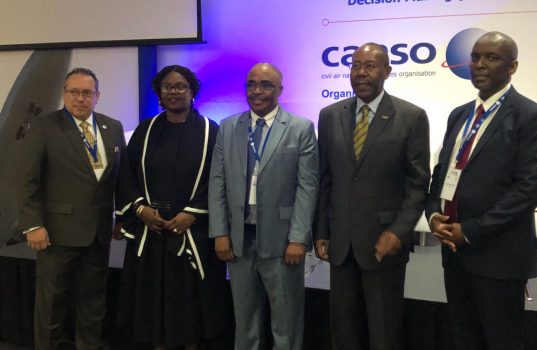Canso Global Vice Chair Encourages Collaborative Decision Making
The Civil Air Navigation Services Organisation (CANSO) Africa Region, in partnership with the International Civil Aviation Organisation (ICAO) and Air Traffic and Navigation Services (ATNS) SOC Limited is hosting the Collaborative Decision Making (CDM) and Airport-Collaborative Decision Making (A-CDM) Symposium, now underway in Durban, South Africa.
The symposium ends on Wednesday, 21 March 2018.
In his opening address, CANSO Global Vice Chair, CANSO Africa Region and ATNS CEO, Thabani Mthiyane, reiterated CANSO Global’s stance in assisting its members in implementing the Airport-Collaborative Decision Making (A-CDM) concept and processes and supporting collaborations that are committed to improving the efficiency of global air transport. ”It is for this reason that this major global aviation organisation has developed a guide and/or roadmap, to its foremost key stakeholders in the aviation industry, by outlining topics for consideration such as the involvement of relevant stakeholders in the regional and local development and implementation initiatives, by providing practical A-CDM information and support in regional seminars and workshops”.
Airport Collaborative Decision Making as a concept is geared towards improving Air Traffic Flow and Capacity Management (ATFCM) at airports by reducing delays, improving the predictability of operations and optimizing utilization of resources. A-CDM is about the partnership between airport operators, aircraft operators/ground handlers, Air Traffic Controllers (ATCs) and Central Airspace Management Units (CAMUs), working seamlessly together in ensuring efficient operations and information/data sharing. Thabani states that “A-CDM offers substantial benefits to all partners by improving the quality of information on which decisions are made, leading to the enhancement of operational efficiency and facilitation of the optimum use of available capacity”.
The 3-day symposium will identify and address CDM-related challenges faced by and opportunities available to the African aviation industry. Among the key challenges to be discussed are the likely delays on the airports surface operations, occurring as a result of apparent inefficient use of installed capacity and or lack of airport infrastructure – in the event of the increasing travel services demand; the perceived lack of equity and access to Air Traffic Management (ATM) and Airport resources that might be attributable to the absence of coordination of common operational solutions and the seemingly inefficient use of aerodrome resources due to the apparent lack of common situational awareness and information sharing. This has the potential to affect predictability and decision making during regular or irregular operations.
Thabani says the concept of CDM is very simple to understand and implement. “Decisions all levels must be made not in isolation but based on a shared, common view of the state of the ATM network with full awareness of the consequences of the decisions on every aspect of the operation. Collaborative in this context does not necessarily imply people sitting together or working together remotely. A single person can also make a collaborative decision if the decision is based on the shared information provided by the partners and if it considers the impact of the decision on those partners and the ATM network.” He pronounces that the CDM starts with the sharing of information and then the making of decisions based on the shared information.
Thabani shared the CANSO Africa Region A-CDM related objectives. These are “fostering a consistent but scalable A-CDM implementation in the Africa Region; gathering regional and local needs to feed Air Navigation Services Providers (ANSPs) implementation initiatives and supporting States and ANSPs in the implementation process”. He is also hopeful that the symposium’s will discuss key issues such as the maintenance of safety levels within the industry, achievement of operational improvements with current scenarios (for example constraints and growing demand), being cost-effective and environmental friendly by encouraging the involvement of all stakeholders (collaborative).
“We have been given a huge task” Thabani reminded the delegates.“ One of the conclusion at the AFI Planning and Implementation Regional Group (APIRG) 21 was that Africa needs to ensure the seamless operations of ATM in order to guarantee the synergetic implementation of an African seamless sky. The Regional Building Block (SADC, EAC, ECOWAS, Roberts FIR, COMESA and ASECNA), were invited to develop a clear and agreed roadmap in consultation with users, for the implementation of seamless, harmonized, interoperable ATM systems and procedures with clear benefits to the aviation stakeholders” He requested the gathering to work towards the achievement of the above.
One important aspect of the ATM environment of the future now includes new aviation-related technologies. The Artificial Intelligence phenomena have huge impact in the way the aviation industry is conducting its business. In South Africa, there is talk about the 4th Industrial Revolution.
There are two main characteristics of the future ATM system, namely net-centricity and trajectory-based operations (TBO). The aim of net-centric operations is to increase the information available to the participating entities and to ensure that data is usable by both anticipated and unanticipated users assuming that they possess the requisite access rights. Collaborative decisions are then made in the context of the interconnected community of systems, applications and people, sharing a common situational awareness of the past, present and future state of the ATM network. In the CDM context, this commitment represents the key to achieving the necessary common situational awareness, interactions between partners based on this awareness and decision making that considers all aspects and consequences of the decisions; not only locally but in the whole of the net-centric environment.
In trajectory-based operations (TBO), the 4D business trajectory submitted to the ATM network by an airspace user represents what the airspace user wishes to perform. The trajectory is meant to result in the best business outcome for the given flight, considering the applicable constraints. The trajectories are owned by the airspace users and necessary changes to them are defined in terms of constraints with the airspace user concerned and deciding the action with which he or she will satisfy such. This will be the case in all circumstances except short-term tactical ATC and airport operational interventions. Trajectory-based operations represent a move away from the traditional clearance and airspace-based paradigm. It requires that the need for data, services, etc. be expressed, with the trajectory (rather than airspace) being central in the descriptions.
The airside/landside division at airports is not something that was introduced in reaction to an operational need. It has everything to do with security, a vitally important aim but not something that should necessarily limit the scope of collaborative decision making. The fact that the definition and the actual location of the airside/landside boundary change from place to place, further (and unnecessarily) complicates things.
Thabani further states that A-CDM is limited to airside processes and there is considerable opposition to what is happening on the landside. “In other words, an artificial, administrative boundary is limiting the full exploitation of CDM’s potential. This will have to change in the future. And that will be for two reasons: in the net-centric environment there is no shortage of information from anywhere, including the landside; secondly, as will be shown, the whole idea of airside and landside should be made invisible from a CDM perspective”.
It has been said that “there is no ‘one-size-fits-all’ A-CDM process or toolset that can be bought off-the-shelf and implemented ready-to-use”. ANSPs, airports and airlines differ in terms of size, strategy, status, constraints, and business models, and each of these differences may require a different form or level of airside A-CDM. The upwards open scope of SWIM should give us a hint as to how the scope of CDM can also be limited only by the actual need for decision making information.
“To properly appreciate the potential of a true System-Wide Information Management (SWIM) environment, we do need to adjust our thinking. An information-driven system needs a major jump in how we see the world. In this expanded scope CDM and SWIM environment, a lot of new, raw data is suddenly available. On the user end, we then have end-user applications that put the data into context, creating information that we can use in any number of ways” Thabani agrees with the argument.
Thabani says the future system must embrace all CDM partners who have useful information to share, regardless of how close or apparently remote they are from traditional ATM. “In the event, that information is made available from traditional as well as new partners, quality decision making can grow in line with the growth of the partner scope. The net result is much improved overall decision making in ATM itself”. “The Silo Effect – Slowing Down Operational Efficiency at Airports” is one of the topics that will be discussed at the event.
Among the dignitaries in attendance are Mr Barry Kashambo, ICAO Regional Director, Eastern & Southern African Office; Mr Sinethemba Mngqibisa Acting Deputy Director-General, Civil Aviation, Department of Transport, South Africa; Ms Boni Dibate, Regional Director CANSO Africa; Mr Stuart Ratcliffe, Co-chair of the CANSO Air Traffic Flow Management Working Group, Metron Aviation; Ms Lindi-Lee KIRKMAN, Manager, Safety& Flight Operations, IATA; Mr Sandile Maphanga, Senior Manager ANS, SACAA; Mr Bradley Stalls, Manager AMC, ACSA and Ms Gaborekwe Khambule, SM Aviation Met Services, SAWS
Mthiyane ended his speech by wishing delegates “luck in your deliberations and discussions, aimed at finding working solutions, that are in the best interest of this critical sector of the global economy”.
Image Attached: (L – R): Rafael Quezada, Operations Programme Manager, CANSO; Ms Boni Dibate, Regional Director CANSO Africa and CANSO Global Vice Chair, Mr Sinethemba Mngqibisa Acting Deputy Director-General, Civil Aviation, Department of Transport, South Africa and CANSO Africa Region and ATNS CEO, Thabani Mthiyane
Related Posts
« Man nabbed with suspected stolen copper cables in Kuruman Alleged hijacker arrested. »



























